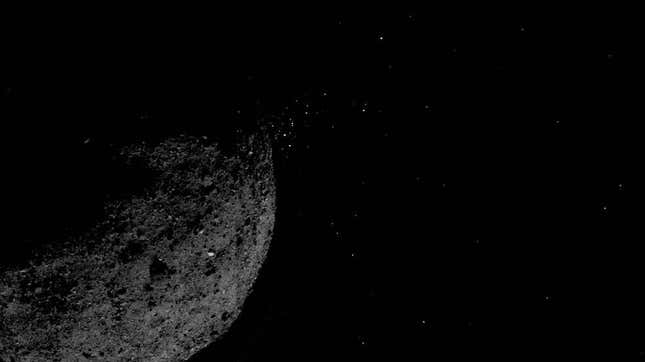
A mighty spacecraft is headed towards Earth, carrying rock and dust from a distant asteroid to hand off to eager scientists waiting to analyze the precious sample. The OSIRIS-REx mission recently fired its thrusters to set itself on a course towards the sample drop-off site, with its rendezvous on Earth scheduled for later this month.
NASA’s OSIRIS-REx spacecraft completed a trajectory correction maneuver on Sunday, altering its velocity by approximately 0.5 miles per hour (under 1 kilometer per hour) relative to Earth, the space agency announced on Monday. If it hadn’t pulled off this critical course correction, the spacecraft would have flown right past Earth.
Advertisement
OSIRIS-REx is scheduled to drop off the sample from asteroid Bennu on September 24. The spacecraft will release a capsule carrying the sample at 10:42 a.m. ET, which will land around 13 minutes after its release in a 36-mile by 8.5-mile (58-km by 14-km) area at the Department of Defense’s Utah Test and Training Range southwest of Salt Lake City, according to NASA.
The spacecraft itself, on the other hand, isn’t staying for long. OSIRIS-REx will deliver its sample and begin making its way towards its next mission, exploring asteroid Apophis. Accordingly, the mission will be renamed to OSIRIS-APEX (OSIRIS-Apophis Explorer).
Advertisement
Advertisement
OSIRIS-REx launched in September 2016 and snagged a sample from asteroid Bennu in October 2020. Since then, the spacecraft has been making its way back to Earth to drop off its precious cargo. This is NASA’s first attempt at retrieving a sample from an asteroid, which scientists will be able to analyze closely to help uncover clues as to how life may have originated on Earth.
The spacecraft is currently at a distance of 4 million miles away from Earth (7 million kilometers), traveling at a speed of about 14,000 mph (about 23,000 km/hr) toward its drop off zone. OSIRIS-REx may need to carry out another course correction maneuver on September 17, one week before its big delivery is due.
For more spaceflight in your life, follow us on Twitter and bookmark Gizmodo’s dedicated Spaceflight page.
Services Marketplace – Listings, Bookings & Reviews